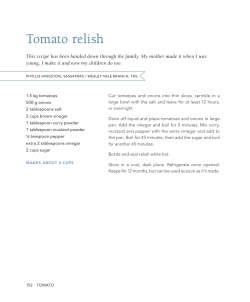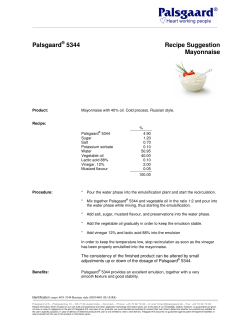
Which Antacid Raises pH the Most? Biochemistry – Division II
Which Antacid Raises pH the Most? Biochemistry – Division II March 6, 2007 Christopher Chan 8th Grade Classen School of Advanced Studies Oklahoma City, OK ABSTRACT The purpose of this project was to find out which antacid neutralizes acid the most. Antacids are commonly used for heartburn or upset stomach. The results could be beneficial for anyone who needs an antacid to soothe their stomach. To do this experiment, I tested seven antacids with vinegar. I chose vinegar instead of hydrochloric acid because it is not corrosive. With a pH of 2, vinegar has an acidity that is similar to the acidity of the stomach. The antacids tested were AlternaGEL, Gaviscon Regular Strength Oral Liquid, Maalox Maximum Strength Multi Symptom Oral Liquid, Mylanta Supreme Oral Suspension, Pepto-Bismol, Extra Strength Rolaids Tablets, and Extra Strength Tums Smoothies Smooth Dissolve Tablets. I added 30 mL of each liquid antacid or three of each type of triturated antacid tablets to 60 mL of vinegar. Then I stirred the mixture. After ten minutes, I measured the final pH of the mixture and recorded the data. I discovered that Mylanta Supreme Oral Suspension neutralized the acid the most. Next was Extra Strength Rolaids Tablets followed by Extra Strength Tums Smoothies Smooth Dissolve Tablets, Gaviscon Regular Strength Oral Liquid, Maalox Maximum Strength Multi Symptom Oral Liquid, and AlternaGEL. Pepto-Bismol neutralized acid the least. The antacids containing a combination of calcium carbonate and magnesium hydroxide neutralized the acid of the vinegar the most. Therefore, the use of Mylanta Supreme Oral Suspension or Extra Strength Rolaids Tablets should be the top choices when choosing effective antacids. INTRODUCTION My experiment is “Which Antacid Raises pH the Most?” The purpose of this experiment was to determine which antacid is the most effective in neutralizing stomach acid. My hypothesis was that if all antacids are not the same, then I can discover the most effective antacid; therefore, I will know which antacid neutralizes acid the most. Antacids are different because the ingredients in them are different. I tested different combinations and forms of antacids. I used oral suspensions and chewable tablets. I tried to find out which antacid is the best. The results of this experiment could be beneficial for anyone who needs an antacid to soothe their upset stomach. An antacid is a type of medicine that neutralizes stomach acid. It is used when your stomach feels upset. The pH level in your stomach is from 1.5 to 2.5. (1) I used vinegar that has five percent acidity for this experiment because vinegar has a pH of 2 and is less corrosive than hydrochloric acid. The stomach produces hydrochloric acid which aids in the chemical digestion of food. The stomach is protected from the acid by a mucous lining. This mucous lining prevents the stomach wall from being eaten up. (2) Antacids neutralize stomach acid. They can be used when you have heartburn, an upset stomach, or acid indigestion. (3) Most antacids contain magnesium hydroxide, aluminum hydroxide, calcium carbonate, or a combination of these. (4) Antacids that contain magnesium can cause diarrhea. Patients in renal failure need to use extreme caution when taking antacids that contain magnesium. Aluminum or calcium containing antacids could lead to constipation. Although antacids bring the quickest relief, they last for a short amount of time. (5) The measure of the hydrogen ion concentration is pH. In the late 1880s, Svante Arrhenius, a Swedish chemist and physicist, said that an acid was made of hydrogen ions. (6) This led to the modern definition of pH today. The pH scale ranges from zero to fourteen with zero being the most acidic and fourteen being the most basic. Seven is neutral. The pH scale uses a logarithmic scale. Therefore, it covers a large range of acidity values. (7) A neutralization reaction occurs when an acid combines with a base. An acid tastes sour when dissolved in water, turns blue litmus paper red, and neutralizes bases. Bases taste bitter and feel slippery when dissolved in water, turn red litmus paper blue, and neutralize acids. When a neutralization reaction occurs, the properties of the mixture are not similar to the properties of the acid or the base. A neutralization reaction produces water and a salt. MATERIALS 4,200 mL of vinegar pH meter 300 mL of AlternaGEL 300 mL of Gaviscon Regular Strength Oral Liquid 300 mL of Maalox Maximum Strength Multi Symptom Oral Liquid 300 mL of Mylanta Supreme Oral Suspension 300 mL of Pepto-Bismol 30 Tablets of Extra Strength Rolaids 30 Tablets of Extra Strength Tums Smoothies Smooth Dissolve Tablets 100 mL graduated cylinder 7- 400 mL beakers 7 glass stirring rods Glass mortar and pestle METHOD 1.) Labeled each beaker from 1 to 7. 2.) Put 60 mL of vinegar in each of the seven beakers. 3.) Measured the pH of the vinegar using the pH meter. 4.) Recorded the pH of the vinegar. 5.) Added 30 mL of AlternaGEL to beaker #1. 6.) Stirred the vinegar and antacid mixture for 10 minutes. 7.) Measured the final pH of the vinegar and antacid mixture with the pH meter. 8.) Recorded the data. 9.) Cleaned the pH meter. 10.) Added 30 mL of Gaviscon Regular Strength Oral Liquid to beaker #2. 11.) Repeated steps 6 through 9. 12.) Added 30 mL of Maalox Maximum Strength Multi Symptom Oral Liquid to beaker #3. 13.) Repeated steps 6 through 9. 14.) Added 30 mL of Mylanta Supreme Oral Suspension to beaker #4. 15.) Repeated steps 6 through 9. 16.) Added 30 mL of Pepto-Bismol to beaker #5. 17.) Repeated steps 6 through 9. 18.) Triturated 3 tablets of Extra Strength Rolaids using the mortar and pestle. 19.) Poured the Extra Strength Rolaids powder into beaker #6. 20.) Repeated steps 6 through 9. 21.) Triturated 3 tablets of Extra Strength Tums Smoothies Smooth Dissolve Tablets using the mortar and pestle. 22.) Poured the powder from the Extra Strength Tums Smoothies Smooth Dissolve Tablets into beaker #7. 23.) Repeated steps 6 through 9. 24.) Washed and dried all 7 beakers. 25.) Repeated steps 1 through 24 nine more times. 26.) Plotted line graph with the x-axis as the antacids and the y-axis as the final pH of the mixture of the vinegar and the antacid. 27.) Plotted line graph with the x-axis as the antacids and the y-axis as the average pH from trial #1 through trial #10 for each antacid. 28.) Plotted line graph with the x-axis as the antacids and the y-axis as the difference in pH from the vinegar and the average pH of each antacid. 29.) Analyzed and evaluated results. RESULTS I discovered that Mylanta Supreme Oral Suspension neutralized the acid the most. The average final pH of Mylanta Supreme Oral Suspension and vinegar after ten minutes was 6.59. The next most neutralizing antacid was Extra Strength Rolaids Tablets followed by Extra Strength Tums Smoothies Smooth Dissolve Tablets, Gaviscon Regular Strength Oral Liquid, Maalox Maximum Strength Multi Symptom Oral Liquid, and AlternaGEL. Pepto-Bismol neutralized acid the least. Pepto-Bismol and vinegar had an average pH of 2.59 after ten minutes. The average variation in pH of the antacid and vinegar mixture was 0.07 for AlternaGEL, 0.13 for Gaviscon Regular Strength Oral Liquid, 0.08 for Maalox Maximum Strength Multi Symptom Oral Liquid, 0.09 for Mylanta Supreme Oral Suspension, 0.08 for Pepto-Bismol, 0.16 for Extra Strength Rolaids Tablets, and 0.11 for Extra Strength Tums Smoothies Smooth Dissolve Tablets. DISCUSSION OF RESULTS The data shows that Mylanta Supreme Oral Suspension neutralized the vinegar the most. The antacids containing calcium carbonate and magnesium hydroxide were Mylanta Supreme Oral Suspension and Extra Strength Rolaids Tablets. These antacids neutralized the vinegar the most. The average final pH of the mixture of Mylanta Supreme Oral Suspension and vinegar after ten minutes was 6.59. The average final pH of the mixture of Extra Strength Rolaids Tablets and vinegar after ten minutes was 5.09. Calcium carbonate and magnesium hydroxide combined to produce the highest pH results in my experiment. The antacids that contained other active ingredients alone or in different combinations such as aluminum hydroxide, bismuth subsalicylate, calcium carbonate, magnesium carbonate, and magnesium hydroxide did not neutralize the pH of the vinegar as much. CONCLUSION Based on the results of this experiment, Mylanta Supreme Oral Suspension is the antacid of choice for the relief of upset stomach, heartburn, and acid indigestion. Mylanta Supreme Oral Suspension should not be used in renal failure because it contains magnesium hydroxide. Elevated magnesium levels can lead to cardiovascular and neurological problems. Mylanta Supreme Oral Suspension may cause hypercalcemia and is contraindicated in patients that have had kidney stones in the past. ACKNOWLEDGEMENT I would like to give special thanks to Ms. Linda Barnett, my science teacher, for supervising and guiding me throughout the Science Fair process. I would also like to thank my parents, Peter and Betty Chan. They supported and encouraged me all the way. They also provided the materials necessary for my project. REFERENCES 1. Walker, P., & Wood, E. (2003). The temporary storage tank. In The digestive system (pp. 1516). Farmington Mills, MI: Lucent Books. 2. Liebow, C., Ph.D. (2006). The stomach’s work. In Stomach. Retrieved November 24, 2006, from World Book Online Reference Center database: http://www.worldbookonline.com/ wb/Article?id=ar534380&st=antacid 3. Minocha, A., M.D., & Adamec, C. (2001). Antacids. In How to stop heartburn: Simple ways to heal heartburn and acid reflux (p. 61). New York: John Wiley and Sons. 4. Yoshida, C. M., M.D., & Kotz, D. (2004). Step 2: Try an over-the-counter heartburn remedy. In No more digestive problems: A leading gastroenterologist provides the answers everywoman needs-real solutions to stop the pain and achieve lasting digestive health (pp. 105-106, 214). New York: Bantam Books. 5. Miskovitz, P., M.D., & Betancourt, M. (2005). Treating reflux disease. In The doctor’s guide to gastrointestinal health: Preventing and treating acid reflux, ulcers, irritable bowel syndrome, diverticulitis, celiac disease, colon cancer, pancreatitis, cirrhosis, hernias, and more (p. 55). Hoboken, NJ: John Wiley and Sons. 6. Karukstis, K. K., & Van Hecke, G. R. (2003). Connections to acids and bases. In Chemistry connections (2nd ed., p. 72). San Diego, CA: Academic Press. 7. Hess, F. C. (1984). PH. In Chemistry made simple (Rev. ed., p. 76). New York: Doubleday. (Original work published 1955)
© Copyright 2025











